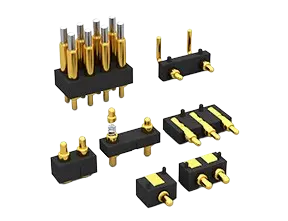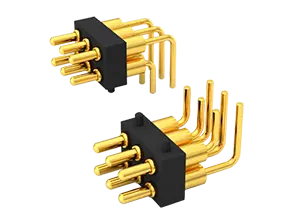Direct soldering: Using solder paste to directly fix the pogo pin connector on the PCB board is the simplest installation method. This method is simple and trouble-free, but the disadvantage is that it is not very stable, and the pogo pin may break away from the PCB board due to vibration interference and pressure.
Pogo pin board fixation: A relatively stable and commonly used way to fix the pogo pin connector on the PCB circuit board is to plug the tail of the pogo pin onto the PCB board and fix it on the PCB circuit board through the tail of the pogo pin . This method will give the pogo pin additional support points, making it more stable.
Plastic base fixing + welding: You can also fix the pogo pin on the plastic base, then install the plastic base to the PCB circuit board, and then use solder paste to weld the pogo pin to the PCB board, so there is double fixation. This method is suitable for most situations and has a certain degree of stability, but the cost will increase relatively.
Pogo pin board fixation + plastic seat fixation + welding: This structure combines the 2 and 3 structures. The pogo pin is first fixed on the plastic base, and then the plastic base is fixed on the PCB board. The tail of the pogo pin is also fixed on the PCB board and then reinforced with solder. This is equivalent to triple reinforcement and the stability is very good.
Flat-bottom pogo pin: The bottom of this type of pogo pin needle tube is flat and the outer diameter of the bottom is larger than the outer diameter of the needle tube, which facilitates vertical patching to the PCB board. This type of pogo pin is from the perspective of installation method It is also called a vertical pogo pin. It is generally used for board-to-board connection, or can be used for external connection. It can be designed to be waterproof.
Pogo pin with tail pin: also called plug-in pogo pin or plug-in pogo pin. This type of pogo pin has the same characteristics as the flat bottom pogo pin. They are both installed vertically on the PCB board. The difference is that the plug-type pogo pin has a tail pin protruding from the end of the needle tube to facilitate plug-in board welding. Of course, pogo pins with tail pins also have tail pins that are bent, so its installation method will be different. It can be at a certain angle with the PCB board, or used for other structural installations.
Double-headed pogo pin: As you can understand from the name, this type of pogo pin has two needles, and both ends are retractable. This type of pogo pin can be used for board-to-board connection, and it is very convenient to connect the two pins. PCB boards are connected.
Floating pogo pin: also called fake double-headed pogo pin. This type of pogo pin is somewhat similar to a double-headed pogo pin. The difference is that one end of it is just a curved surface instead of a spring pin structure. The application of this type of product Rather special.
There are other special-shaped types of pogo pins, so the pogo pin itself is a specially customized product based on actual applications. If you want to buy pogo pins, just be free to contact us, your raliable and professional pogo pin supplier in China.
Pogo Pin Connectors Related News

